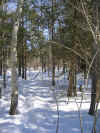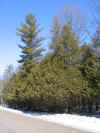 |
Shadows dance in
the bright winter sun under these mature cedar trees; the dried
weeds join in to create a tangled weave. |
 |
This
crystal clear water emanates from the end moraine located to the west of
the bush, where it has been filtered naturally through beds of gravel and
clay before it seeps out of the hillside. From here, Harrington Creek
flows
into Trout Creek and then again Harrington Pond to the north
of the village. According to the 2001 Report Card from the Upper Thames
Conservation Authority, this pristine head water of the Upper Thames River
is one of its last tributaries to remain unpolluted. For more
information, see the following link: http://thamesriver.org/Watershed_Report_Cards/TroutCreek.pdf |
 |
Cedars thrive
in the moist environment surrounding this section of Harrington
Creek. "Wetlands once covered 28% of the land
in southernmost Canada but now are reduced to 5%." Carolinian
Canada |
 |
A footpath
trails softly through the mixed forest, providing a quiet refuge where one
can often enjoy the busy chatter of winter birds hardy enough to withstand
the winter cold. |
 |
Water so clear and cold, but teaming with fish
life according to the Upper Thames
Conservation Authority 2001 Report which gave Trout Creek it the second highest
quality rating of any of
the tributaries in this river system. The County
of Oxford Groundwater Protection Study states in its recommendations:
"However, significant areas of Oxford County are underlain by aquifers which are highly vulnerable to contamination by human activities. Considering the importance of Oxford's groundwater supply and the County's reliance on this "sole source" of drinking water, it is considered critical that the supply be managed and protected now and for the future." |

Up

|
A
white pine
towers above neighbouring cedars in this maturing forest. The following
link provides historical notes on the Story
of Canadian white pine. Another relevant link: hStudying
White Pine Regeneration.
From the County
of Addington & Lennox website: "Eastern White Pine - Pinus strobus
The Provincial tree of Ontario it is the most valuable soft wood in the forest industry. Eastern White pine, because of its shade intolerance, is known as a super-canopy tree growing quite a bit higher than the rest of the trees in the forest community. As the tree grows older it develops a thick bark that is resistant to fire thereby making propagation easier by eliminating competitors and preparing a seed bed. White pine is distinguishable from the rest of the pines because the needles grow in clumps of five and are soft to touch.
This species does not deal with urban stresses easily and is subject to salt damage and pollution."
"Protection of all woodlands and
Locally Significant Wetlands at the municipal planning level is a very
important and effective method of preserving local forest cover."
Upper Thames River
Conservation Authority, Report Card 2001
|
|
|
|
|
|
|
|
|






![]()